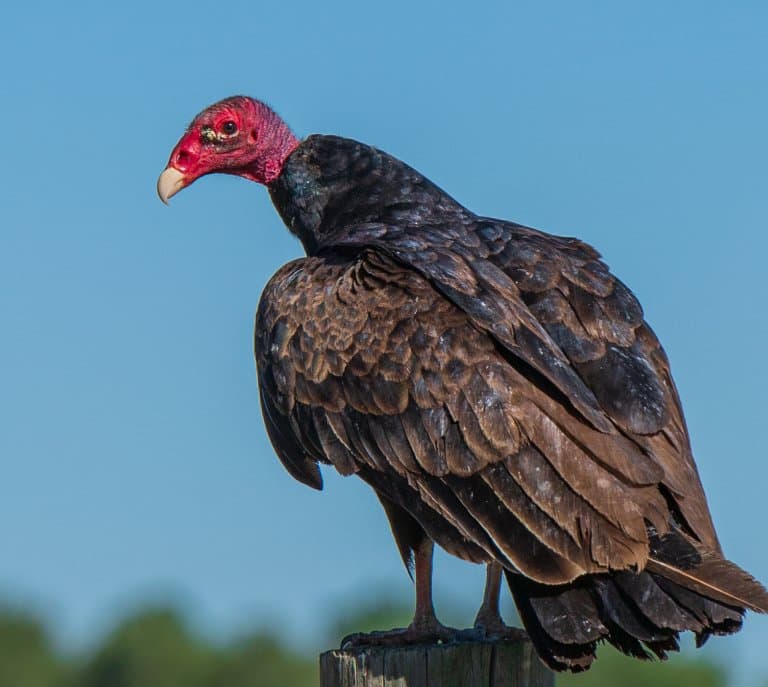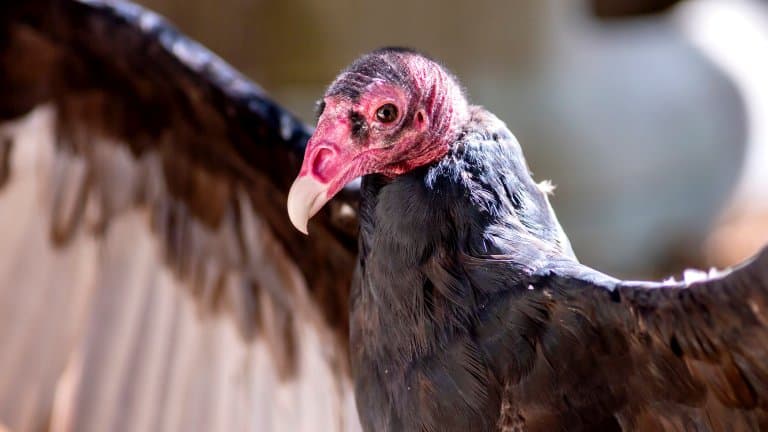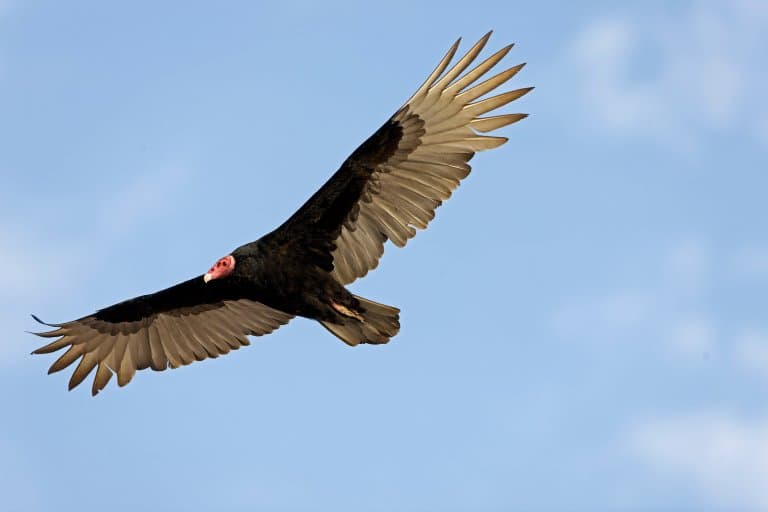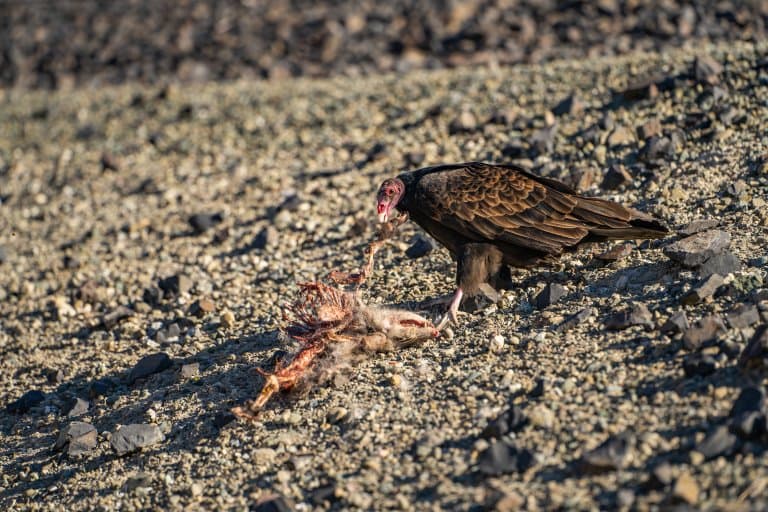Turkey Vulture Profile
The raptors are a diverse group of birds, known for their mean faces and ability to kill things really well. A whole group of them moved away from killing into the emerging markets of rotting meat and became the Old-World vultures we know and love.
But there was a similar group from North America who, until recently were thought to have evolved down similar lines, independently from the raptors of the Africa, Asia and Europe.
But new research suggests they may well be related, and as their taxonomy becomes clearer, there’s never been a better time for the American carrion-feeders to call themselves vultures.
And of them all, the turkey vulture is the most successful.
The turkey vulture inhabits open areas, forests, shrublands, pastures, and deserts from Southern Canada all the way down to Southern South America.

Turkey Vulture Facts Overview
| Habitat: | Open and semi-open areas, subtropical forests, shrublands, pastures, deserts. |
| Location: | Southern Canada to the southernmost tip of South America. |
| Lifespan: | 16 in the wild, 45 in captivity |
| Size: | 80cm (32 inches) tall, 1.8m (72 in) wingspan |
| Weight: | Up to 2.4kg (5.3lb) |
| Colour: | Mostly brownish-black, red head, silvery-grey flight feathers. |
| Diet: | Carrion, occasionally plant matter, live insects. |
| Predators: | Few, some other large birds and mammals |
| Top Speed: | Unknown |
| No. of Species: | 1 |
| Conservation Status: | Least Concern (IUCN) |
Turkey Vultures aren’t turkeys, and their relationship with vulture species is a bit confusing too.
It was one thought that they were terrifying, death-eating storks, but after all the confusion it appears they are as they appear: raptors.
Whether they’re in the same family, or in a sister group, to their Old-World cousins remains to be seen, but whatever they are, these are highly adaptable, wildly successful birds who deserve some recognition!
Interesting Turkey Vulture Facts
1. They aren’t turkeys
There are over 20 species of birds known as vultures, and their taxonomy is a bit muddled. The Old-World vultures are relatively straightforward, but there is a group of American birds whose relationship with them is still under assessment.
Turkey vultures are part of this group, and so named because they have red, featherless heads, sort of like a turkey. This is the only reason, though, and not because they’re remotely related to turkeys, or even that they really eat turkeys, although they probably would if they showed up at Thanksgiving and everyone had left it just sitting there at the table.

2. They’re New-World Vultures
Old World vultures are the ones related to eagles and buzzards and other raptors, whose prey drive has mostly worn off and who are happy to scavenge carrion from animals with more energy to hunt, and then there are the ones in the Americas, whose origin is a bit hard to determine.
Turkey vultures are vultures, but they’re New World vultures, and these were once thought to be a branch of storks that have picked up a taste for rotting meat.
However, recent DNA research suggests they might be more related to the first group than we thought, and that New World vultures may indeed be a sister group to the Accipitriformes, or raptor order.
Regardless, turkey vultures are one of about seven species of New World vultures, so named for their distribution across the Americas. 1
3. They’re very adaptable
As far as the distribution of this species goes, it’s the most widespread vulture in the Americas. They range from Southern Canada, all the way down into South America, and most places in between.
They achieve this incredible range by being highly adaptable as a species and can be comfortable in anything from arid, open areas to thicker woodlands and forests.
Its habitat preference is a mix of these two extremes, and it will happily scavenge meat from various sources within it. They’ll also thrive amid human refuse and can eat what gets thrown away in the cities.
But they’ll also kill things on occasion, such as young birds or sick mammals. They’ll even eat plant matter like pumpkins and coconuts, increasing their option across a range of circumstances. 2
4. They forage by smell
This is uncommon in the bird world, where sight is typically used.
Turkey vultures will hover low to the ground to detect the odour of ethyl mercaptan, a gas created by the start of decay in dead animals.
Due to this, other birds such as black vultures and condors will follow the turkey vulture to find carcasses.

5. They’re the most migratory of the NW vultures
Not only do these vultures thrive across the continents, they move through them, too. They’re considered partial migrants because some populations move more than others.
Populations in the North migrate more, coming down from the cold during Winter and heading back up when it’s more temperate. The longest trips are from the Western US down to Mexico and South America, and some of these trips can include thousands of birds.
6. They’re posers
Turkey vultures display a behaviour that’s known as Horaltic pose. This is basically a power stance with the wings spread wide, and researchers can’t agree on exactly why it’s happening.
Some suggest it’s a way of drying the bird’s wings, warming the body, or getting UV treatment for parasites they might have. It’s much more common after damp nights, so it could have a thermoregulating component to it, but whatever it is, it looks really cool! 3
7. They pee on their own legs
Speaking of cool, these birds engage in urohidrosis, which is a fun way to say they pee on themselves.
Since they can’t sweat, wet bird excreter functions as a medium for evaporative cooling, and is released onto the bald skin of the legs, which they do in public and even at social gatherings, suggesting they’re just no shame in it in their community. 4
8. They feed chicks by regurgitating
Turkey vultures will typically lay two eggs on cliffs, caves or rock crevices. Chicks will hatch 30-40 days later and be cared for by both parents for 10-11 weeks.
During this time, adults will regurgitate food for them until they leave the nest between 8-11 weeks.

9. They’ve had a bad time
Wetting your legs with your own waste is enough to ruin a relationship but the image issues these vultures have faced among the human populations don’t stem from their pooping habits.
Many used to believe these carrion feeders brought disease with them, and some thought it would kill livestock, so they have been persecuted historically, despite the fact that neither is true.
In fact, this species is complicit in the reduction of disease by way of removing waste and rotting meat from the system.
In the United States, turkey vultures are protected by the Migratory Bird Treaty Act of 1918, which makes killing them illegal.
10. They’re doing fine
And despite their troubles, this species is doing great. It’s estimated that there are over 18 million individuals left, covering an incredible range of over 28 million square kilometres.
This is one of the most abundant raptorial birds in the world.
Turkey Vulture Fact-File Summary
Scientific Classification
| Kingdom: | Animalia |
| Phylum: | Chordata |
| Class: | Aves |
| Order: | Accipitriformes |
| Family: | Cathartidae |
| Genus: | Cathartes |
| Species: | Cathartes Aura |
Fact Sources & References
- “New World vulture”, New World Encyclopedia.
- “Turkey Vulture”, Hawk Mountain.
- Alistair (2018), “Horaltic vultures”, Exploring Kootenay Lake.
- “Turkey Vulture”, The Peregrine Fund.
